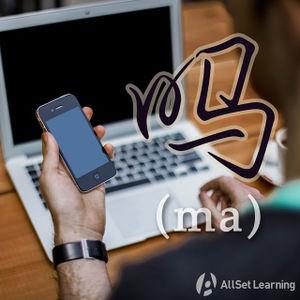Difference between revisions of "Yes-no questions with "ma""
m (Text replacement - "</span> <span class=" to "</span><span class=") |
|||
| Line 49: | Line 49: | ||
*爸爸 喜欢 喝 茶 <em>吗</em>? <span class="expl">question</span><span class="pinyin">Bàba xǐhuan hē chá <em>ma</em>?</span><span class="trans">Does dad like drinking tea?</span> | *爸爸 喜欢 喝 茶 <em>吗</em>? <span class="expl">question</span><span class="pinyin">Bàba xǐhuan hē chá <em>ma</em>?</span><span class="trans">Does dad like drinking tea?</span> | ||
| − | *你们 也 去。 <span class="expl">statement</span><span class="pinyin">Nǐmen yě qù.</span> <span class="trans">You also go.</span> | + | *你们 也 去。 <span class="expl">statement</span><span class="pinyin">Nǐmen yě qù.</span><span class="trans">You also go.</span> |
*你们 也 去 <em>吗</em>? <span class="expl">question</span><span class="pinyin">Nǐmen yě qù <em>ma</em>?</span><span class="trans">Are you also going?</span> | *你们 也 去 <em>吗</em>? <span class="expl">question</span><span class="pinyin">Nǐmen yě qù <em>ma</em>?</span><span class="trans">Are you also going?</span> | ||
| − | *他 在 你们 学校 学 中文。 <span class="expl">statement</span><span class="pinyin">Tā zài nǐmen xuéxiào xué Zhōngwén.</span> <span class="trans">He studies Chinese in your school.</span> | + | *他 在 你们 学校 学 中文。 <span class="expl">statement</span><span class="pinyin">Tā zài nǐmen xuéxiào xué Zhōngwén.</span><span class="trans">He studies Chinese in your school.</span> |
| − | *他 在 你们 学校 学 中文 <em>吗</em> ? <span class="expl">question</span><span class="pinyin">Tā zài nǐmen xuéxiào xué Zhōngwén <em>ma</em>?</span> <span class="trans">Does he study Chinese in your school?</span> | + | *他 在 你们 学校 学 中文 <em>吗</em> ? <span class="expl">question</span><span class="pinyin">Tā zài nǐmen xuéxiào xué Zhōngwén <em>ma</em>?</span><span class="trans">Does he study Chinese in your school?</span> |
*我 见 过 他 。 <span class="expl">statement</span><span class="pinyin"> Wǒ jiàn guo tā.</span><span class="trans">I've met him.</span> | *我 见 过 他 。 <span class="expl">statement</span><span class="pinyin"> Wǒ jiàn guo tā.</span><span class="trans">I've met him.</span> | ||
| Line 59: | Line 59: | ||
*妈妈 会 做饭。 <span class="expl">statement</span><span class="pinyin">Māma huì zuòfàn.</span><span class="trans">Mom knows how to cook.</span> | *妈妈 会 做饭。 <span class="expl">statement</span><span class="pinyin">Māma huì zuòfàn.</span><span class="trans">Mom knows how to cook.</span> | ||
| − | *妈妈 会 做饭 <em>吗</em>? <span class="expl">question</span><span class="pinyin">Māma huì zuòfàn <em>ma</em>?</span> <span class="trans">Does mom know how to cook?</span> | + | *妈妈 会 做饭 <em>吗</em>? <span class="expl">question</span><span class="pinyin">Māma huì zuòfàn <em>ma</em>?</span><span class="trans">Does mom know how to cook?</span> |
*你 昨天 没 去 上班。 <span class="expl">statement</span><span class="pinyin">Nǐ zuótiān méi qù shàngbān.</span><span class="trans">You didn't go to work yesterday.</span> | *你 昨天 没 去 上班。 <span class="expl">statement</span><span class="pinyin">Nǐ zuótiān méi qù shàngbān.</span><span class="trans">You didn't go to work yesterday.</span> | ||
Revision as of 03:48, 24 May 2017
-
Level
-
Similar to
-
Used for
-
Keywords
The question particle 吗 (ma) is a simple way to form questions in Chinese. By placing 吗 (ma) on the end of a statement, you convert it into a yes/no question (questions that could be answered with "yes" or "no" in English).
Contents
Basic Usage
Structure
Any statement can be converted into a yes/no question with 吗 (ma). You could think of 吗 (ma) as being like a question mark you say out loud. So the basic structure is:
[Statement] + 吗 ?
Examples
- 你 喜欢 咖啡 。 statementYou like coffee.
The sentence "You like coffee" can easily be converted into the question "Do you like coffee?" by adding 吗 (ma):
- 你 喜欢 咖啡 吗? questionDo you like coffee?
More examples of statements and their yes/no question forms:
- 你 是 大 学生。 statementYou are a college student.
- 你 是 大 学生 吗? questionAre you a college student?
- 他 是 老板。 statementHe is the boss.
- 他 是 老板 吗 ?questionIs he the boss?
- 你 喜欢 她。 statementYou like her.
- 你 喜欢 她 吗 ? questionDo you like her?
- 你 想 家。 statementYou miss home.
- 你 想 家 吗? questionDo you miss home?
- 爸爸 喜欢 喝 茶。 statementDad likes drinking tea.
- 爸爸 喜欢 喝 茶 吗? questionDoes dad like drinking tea?
- 你们 也 去。 statementYou also go.
- 你们 也 去 吗? questionAre you also going?
- 他 在 你们 学校 学 中文。 statementHe studies Chinese in your school.
- 他 在 你们 学校 学 中文 吗 ? questionDoes he study Chinese in your school?
- 我 见 过 他 。 statementI've met him.
- 我 见 过 他 吗? questionHave I met him?
- 妈妈 会 做饭。 statementMom knows how to cook.
- 妈妈 会 做饭 吗? questionDoes mom know how to cook?
- 你 昨天 没 去 上班。 statementYou didn't go to work yesterday.
- 你 昨天 没 去 上班 吗 ? questionDid you not go to work yesterday?
It's important to remember that you do not normally add 吗 (ma) to a sentence that's already a question. For example:
- 你 是 谁 吗?谁 is a question word
- 这 是 不 是 书 吗?是不是 is a question pattern
These would be something like "Are you who are you?" and "Is this is a book?" in English, both obviously ungrammatical. Still, if you're not careful, you may find yourself throwing a 吗 (ma) onto the end of a question that doesn't need it. Many learners make this mistake, so don't worry if it happens every once in a while, just catch it and remember it the next time.
More Advanced Usage
However, this doesn't mean that a sentence can't ever have a question word and 吗 (ma). If a sentence contains verbs of understanding such as 知道 (zhīdào),了解 (liǎojiě), 明白 (míngbai), 认识 (rènshi), etc., then 吗 (ma) can still be added at the end of the question.
This is not a necessary pattern for a beginner to know, but you may also wish to read about advanced yes-no questions with "ma".
See also
Sources and further reading
Videos
- Yoyo Chinese: Yes-no Questions with 吗
Books
- Chinese: An Essential Grammar, Second Edition (pp. 138-40) →buy
- Integrated Chinese: Level 1, Part 1 (3rd ed) (pp. 29-30) →buy
- New Practical Chinese Reader 1 (新实用汉语课本1) (p. 21) →buy
- New Practical Chinese Reader 1 (新实用汉语课本1)(2nd ed) (pp. 23, 250) →buy



